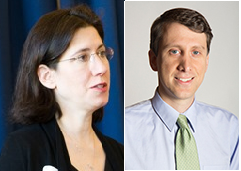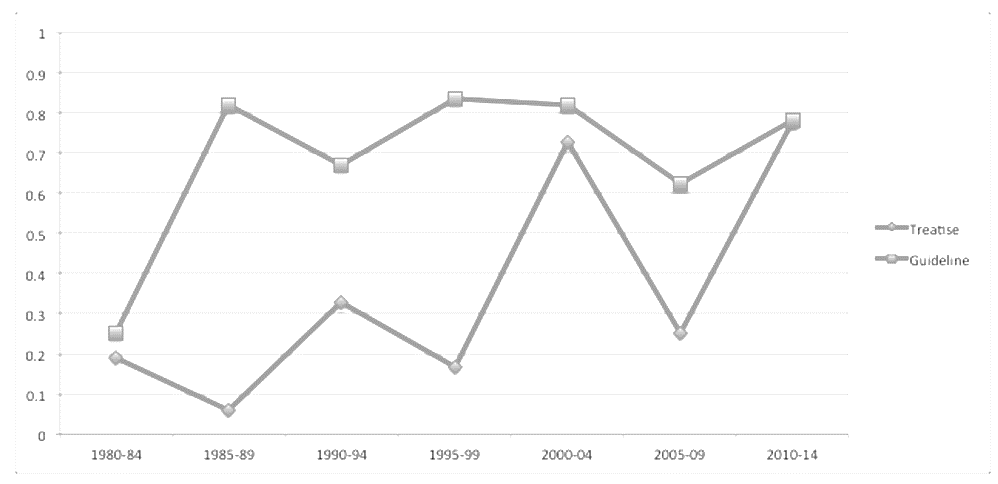With over 4000 citations in the Westlaw JLR database (most referencing his antitrust scholarship), Hovenkamp is one of the most cited legal scholars. His citations reflect an enormous body of work including the 21-volume Antitrust Law: An Analysis of Antitrust Principles and Their Application (“Treatise”)[1] upon which we primarily focus. Hovenkamp’s scholarship has shaped both academic and judicial discourse. Justice Breyer once remarked that litigants “would prefer to have two paragraphs of [the Areeda–Hovenkamp] treatise on their side than three Courts of Appeals or four Supreme Court Justices.”[2]
During the 1970s, antitrust began its revolution to a more economics-based approach. The antitrust doctrines of today bear little resemblance to those of a couple of generations ago.[3] Antitrust has sought to incorporate more workable legal rules, regarding both substance and process, that better reflected economic thinking.[4] We attempt to convey Hovenkamp’s considerable role in this transformation through analysis of citations to and textual analysis of decisions regarding Hovenkamp’s scholarship and/or the Treatise.
In total, 473 district court, 328 circuit court, and 23 Supreme Court decisions cite either the Treatise since Hovenkamp became a co-author in 1984 or Hovenkamp’s scholarship. One useful comparison is to academics with significant careers as circuit court judges. As judges, Bork and Posner’s opinions, which this study does not measure, influenced antitrust law. And, whereas, Bork and Posner’s writings often challenged antitrust’s very foundation, many of Hovenkamp’s citations concern questions of law rather than policy. Nonetheless, the statistics from the last twenty-five years are telling. The federal courts have cited Bork 58 times, Posner 31 times, and Hovenkamp 781 times. With regard to the Roberts-led Supreme Court’s substantive antitrust decisions, Treatise citations are both frequent and meaningful; Hovenkamp has been cited in every substantive antitrust decision since 2007.[5]
Hovenkamp’s influence has been particularly pronounced in judicial rulings (162 citations) regarding antitrust injury and standing. We analyzed antitrust injury in the context of private merger suits. The Treatise advocated, based in part on Hovenkamp’s academic writing,[6] that antitrust injury should screen out situations that on average were a result of efficient behavior. [7] Hovenkamp’s Treatise and non-Treatise work seem to have influenced judicial decisions towards limiting cases to those demonstrated that the plaintiff suffered an economic-based antitrust injury.
Our essay also presents basic citation statistics as well as a closer textual analysis for select judicial rulings involving substantive merger determinations. Federal court decisions between 1980 and 2014, both published and unpublished that involve the Department of Justice (DOJ) or the Federal Trade Commission (FTC), constituted the data for the statistical exercise.[8] Albeit a noisy signal, these statistics provide insight into the Treatise’s influence. It is instructive to use citations to the federal antitrust agencies’ merger guidelines as a comparison and baseline.
Until the 1980s the courts did not acknowledge efficiencies as a possible defense to an otherwise anticompetitive merger.[9] While DOJ’s 1982 Guidelines acknowledged an efficiency defense, its role was expanded when they were revised in 1984 – a change that the Treatise arguably influenced. Particularly after the 1984 Guidelines, the efficiencies defense occupied a modest “recurring role” within a number of federal court rulings throughout the 1980s. Most of those decisions referenced the Guidelines, though not always when assessing efficiency claims; only two referenced the Treatise. Given the state of the law, it is unclear whether most of the district courts would have been as receptive to efficiencies arguments without the Guidelines’ imprimatur. Arguably the Guideline’s added authority was important as a channel of influence for ideas developed elsewhere including in the Treatise.
Long standing, albeit only sporadically acknowledged, questions regarding the role of efficiencies resurfaced in 1991. The court in FTC v. University Health recognized, albeit in dicta, that “an efficiency defense to the government’s prima facie case in section 7 challenges is appropriate in certain circumstances.”[10] The decision drew heavily from the Treatise. Over the next decade, half of the merger rulings that addressed efficiencies directly referenced FTC v. University Health, though none directly referenced the Treatise.
Most notably the antitrust agencies expanded their treatment of efficiencies through guideline revisions in 1997. Again the Treatise appeared to be influential. FTC Chairman Robert Pitofsky who championed this effort noted, “In my view, the Areeda–Turner Treatise (as is so often the case in antitrust analysis) offers the most thoughtful guideline to evaluating different types of efficiency.”[11]
The next critical juncture occurred shortly thereafter. In 2000 the FTC v. Heinz ruling, the D.C Circuit noted the lack of appellate precedent regarding efficiencies and the case’s complicated nature given “the high concentration levels present.”[12] The court quoted the Treatise which supported an “efficiencies defense but [would] requir[e] ‘extraordinary’ efficiencies’” in highly concentrated markets.[13] While this “extraordinary” gains language first appeared in the 1998 Treatise, the underlying arguments regarding a limited use of efficiencies had long been a part of the broader antitrust discourse including in prior Treatise installments. Nonetheless, it was this phrasing, as reflected in Heinz, that was then explicitly relied upon in more than half of the merger decisions that have substantively addressed an efficiency defense. Those cases that did not reference this “extraordinary” language generally involved circumstances in which this criterion was not particularly germane.
How does academic literature influence the common law? To answer this question, it is crucial to consider how various ideas gain attention and hence influence and this depends in turn on the demand for and the supply of ideas in judicial settings. The demand for ideas depends, for example, on the degree to which the law is changing, perhaps because of new legislation, changes in the supporting social science, changes in the types of fact patterns, and the state of judicial guidance. In the context of U.S. antitrust merger law, many of these factors increased the demand for ideas.
The supply of ideas depends on factors including changes in social science and changes in institutions that give credibility to some ideas. One source of ideas was the federal antitrust agencies’ Guidelines, while technically non-binding, nonetheless, became increasingly relied on and arguably eventually became an “institution.”[14] Both the Guidelines and the Treatise were influential in part because they provided one-stop authoritative guides for analysis. The Guidelines were well-exercised and debated; the Treatise was a more expansive source for a summary of the state of the law, a discussion of relevant debate, and well-argued recommendations for what the law should be. The Treatise complemented the Guidelines.
Individual legal analyses, of course, do this too. But, putting aside questions about the novelty or superiority of the arguments, the Treatise has major advantages in terms of potential influence because it was comprehensive and easily accessible. Furthermore, this Treatise, or shall we say The Treatise, has the authority of top legal scholar authors and a long-standing, carefully cultivated reputation for top quality. And, as we know, market power is permissible when it derives from superior acumen.
ENDNOTES
[1]. Phillip E. Areeda and Donald F. Turner were the Treatise’s original authors. Hovenkamp’s co-authorship began in 1984. Numerous scholars have contributed to the Treatise over the years including: Roger D. Blair, Christine Piette Durrance, Einer Elhague, and John L. Solow. See id. Its current volumes span the work’s third or fourth edition.
[2]. Stephen Breyer, In Memoriam: Phillip E. Areeda, 109 Harv. L. Rev. 889, 890 (1996).
[3]. See, e.g., D. Daniel Sokol, The Transformation of Vertical Restraints: Per Se Illegality, the Rule of Reason, and Per Se Legality, 79 Antitrust L.J. 1003 (2014).
[4]. See generally Herbert Hovenkamp, Harvard, Chicago, and Transaction Cost Economics in Antitrust Analysis, 55 Antitrust Bull. 613 (2010).
[5]. During this time the Supreme Court cited to Bork’s scholarship only three times, none more recent than 2007, and it did not cite to Posner’s scholarship.
[6]. See generally Herbert Hovenkamp, Antitrust’s Protected Classes, 88 Mich. L. Rev. 1 (1989).
[7]. See Herbert Hovenkamp, The Areeda–Turner Treatise in Antitrust Analysis, 41 Antitrust Bull. 815, 829 (1996).
[8]. In 1978, Treatise Volumes I-III were published. Volume IV, which includes mergers, was first published in 1980. The Treatise was referenced only once in a merger context prior to 1980.
[9]. See, e.g., Fed. Trade Comm’n v. Procter & Gamble Co., 386 U.S. 568 (1967); RSR Corp. v. Fed. Trade Comm’n, 602 F.2d 1317 (9th Cir. 1979).
[10]. Fed. Trade Comm’n v. Univ. Health, Inc., No. CV191–052, 1991 WL 117432 (S.D. Ga. Apr. 3, 1991).
[11]. Robert Pitofsky, Former Chairman, Fed. Trade Comm’n, FTC Staff Report on Competition Policy: Six Months After (Nov. 7, 1996).
[12]. Fed. Trade Comm’n v. H.J. Heinz, Co., No 00-5362, 2000 WL 1741320, at *2 (D.C. Cir. Nov. 8, 2000) (per curiam), aff’d, 246 F.3d 708, 720 (2001).
[13]. 2000 WL 1741320, at *2 (citation omitted).
[14]. See Hillary Greene, Guideline Institutionalization: The Role of Merger Guidelines in Antitrust Discourse, 48 Wm. & Mary L. Rev. 771, 806 (2006).
The preceding post comes to us from Hillary Greene & D. Daniel Sokol. This post is based on their essay, which is entitled “Judicial Treatment of the Antitrust Treatise” and is available here.
 Sky Blog
Sky Blog

